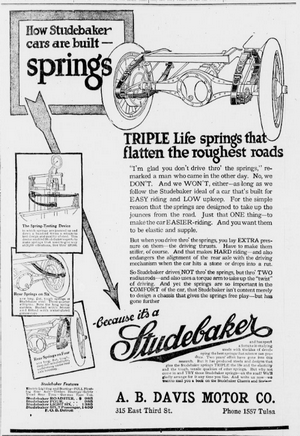|
By accessing/using The Crittenden Automotive Library/CarsAndRacingStuff.com, you signify your agreement with the Terms of Use on our Legal Information page. Our Privacy Policy is also available there. |

Mechanical Advertising Explained by Williams
|
|---|
|
|
Mechanical Advertising Explained by Williams
George L. Williams
Tulsa Daily World
April 25, 1915 - Morning Edition
By George L. William (Studebaker's Advertising Manager.)
 This ad ran on the same page as the article This ad ran on the same page as the article
|
Whenever business has called me to a city or town where I could get in touch with local automobile conditions in the last year or two, I have been struck by the interest of the prospective buyer in the mechanism of the car he is inspecting. This, contrary to the to the pretty general belief that people buy cars on size and looks only. It is this eager desire for exact knowledge which had the largest influence in causing us to prepare a series of advertisements dealing with the mechanical features of Studebaker cars. We decided to use these advertisements in newspapers because we regard them as the medium that is immediately responsible.
The time has gone by when an automobile is purchased merely because it is good looking. Yet designers still strive for the streamline effect that is so well exemplified in Studebaker cars because beauty is a satisfying adjunct to mechanical excellence. Once on a time the man about to buy an automobile looked only at the lines of the hood, today he is vitally and intelligently interested in what lies under the hood.
Since the work of the advertising department is to tell the public what it wants to know and what it should know about automobiles in order to purchase intelligently, naturally we are keen to get our story as quickly as possible to these people. Having decided to give them what one might call an education in the mechanical features of the Studebaker car, we are using the newspapers because we can keep our hands on the pulse of public interest and amplify any of these talks almost in a day if we find there are reasons for doing so because of local conditions in any part of the country. It should not be forgotten that people buy Studebakers in the hot parts of lower California and Arizona because of their perfect cooling system, while in western Canada they may be preferred because their balance and sturdiness makes them best in a new country over uncertain roads. This ability to change the advertising is possible only where it is appearing in such a flexible medium as the newspapers.
All in Front Wheels.
The Studebaker corporation is particularly interested in the prospective buyer who asks questions. It is a sign that he is going to be a careful, discriminating owner. There are questions and questions; yet, it is not difficult to classify practically all of them and prepare educational reading matter that will answer about all the queries and set at rest all the doubts. In my personal contact with buyers the only question I ever found hard to answer was that of the pretty young lady who remarked after a long explanation, "Yes, I think I know what makes the back wheels go 'round, but what makes the front wheels go?"
The newspaper advertisements we are running in April are merely what the Studebaker dealer says to customers when they come in singly to the Studebaker showroom. By putting the dealers' answers in the form of newspaper announcements we aim to reach thousands in the same time that the dealer can talk to one or two or three. The educational advertising we have already used has shown that the man who plans to buy a car not only reads it and studies over it, but he lays it aside and comes back to it. There is no chance for him to misunderstand, because he can study over the mechanical problem mastered by Studebaker engineers until he has the proper appreciation of the difficulties that have been solved in making a car that will give him thorough satisfaction. The advertisements are illustrated to make them easier to understand.
In these mechanical advertisements we have a comprehensive guide to the machine. With their drawings they give the owner an understanding of the details of construction and operation. So, in this fashion we show the economical Studebaker motor with the carburetor placed high to shorten the distance the gas travels to the cylinders, with the simple, extremely accessible electric generator, and the noiseless self-starter. Then, too, we show how every detail of the chassis is in easy reach, how it is balanced by an even distribution of weight, and how the line of drive loses no power through transmission at an angle, since it is as straight as a shot from the motor back to the rear axle.
One can appreciate the simplicity of the Studebaker when one considers that the very vitals of the car can be so readily understood through such a series of newspaper advertisements.

















 This ad ran on the same page as the article
This ad ran on the same page as the article
